The archaeologists digging under the Leicester parking lot for the Greyfriars church where King Richard III was buried in 1485 started out with a long list of ifs and maybes. They weren’t sure they had the right location for the church which had been destroyed during Henry VIII’s dissolution of the monasteries in 1538 and built over for centuries. Even if their research on the location did turn out to be have been correct, there might be no remains left after the Tudor destruction and subsequent development. If there were physical remains of the abbey and church left to be found, they might not have found them in the two trenches they planned to dig. If they did find physical remains of the church, they might not have been sufficient to map an accurate ground plan and find the choir area where Richard was buried. If they did locate the choir area, there might be nothing there. If they did find human remains, they wouldn’t necessarily be significant since many people were buried in abbeys in churches.
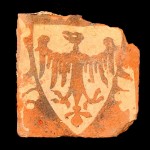 Knowing how the long the odds were of discovering anything pertinent at all, the University of Leicester’s excavation team was not so much cautiously optimistic as just plain cautious. They underscored that the archaeological search would nonetheless provide a fascinating window into the long-lost history of Leicester even when/if nothing Richard-specific was discovered. It was an exercise in managing expectations, as they say in the corporate world, not just the public’s but their own.
Knowing how the long the odds were of discovering anything pertinent at all, the University of Leicester’s excavation team was not so much cautiously optimistic as just plain cautious. They underscored that the archaeological search would nonetheless provide a fascinating window into the long-lost history of Leicester even when/if nothing Richard-specific was discovered. It was an exercise in managing expectations, as they say in the corporate world, not just the public’s but their own.
Then something completely unexpected happened: everything went right. The two trenches immediately revealed the remains of tiled walkways which proved to be the eastern cloister walk of the friary. They found part of the wall of the chapter house abutting it. Spurred by these promising discoveries, the archaeological team dug a third unplanned trench into a neighboring parking lot and found the walls of the church within the friary.
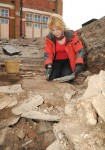 The next discovery was more than anyone had dared hope, or at least voice. Outside of the church perimeter to the south, the team unearthed a stretch of paving made of recycled medieval tiles of different sizes and wears laid in a random pattern. They believe these are the remains of the garden of Sir Robert Herrick, mayor of Leicester. Herrick bought the abbey land in the early 1600s and built a mansion and gardens on the site. Christopher Wren, future father of the famous architect, was tutor to Herrick’s nephew. He
The next discovery was more than anyone had dared hope, or at least voice. Outside of the church perimeter to the south, the team unearthed a stretch of paving made of recycled medieval tiles of different sizes and wears laid in a random pattern. They believe these are the remains of the garden of Sir Robert Herrick, mayor of Leicester. Herrick bought the abbey land in the early 1600s and built a mansion and gardens on the site. Christopher Wren, future father of the famous architect, was tutor to Herrick’s nephew. He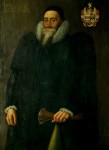 recorded that there was a pillar on the grounds inscribed “Here lies the body of Richard III, some time King of England.”
recorded that there was a pillar on the grounds inscribed “Here lies the body of Richard III, some time King of England.”
Meanwhile, in the third trench inside the church area, archaeologists found large chunks of window tracery and a lead window H-section (part of the support for a stained glass window). There was a large window behind the high altar in the east of the church. The choir where Richard III was buried was in the east side of the church. They also found a medieval silver penny, a stone frieze they think was part of the choir stalls and copper alloy letters that might have come from tomb inscriptions.
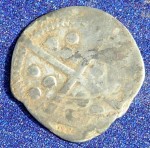
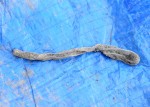
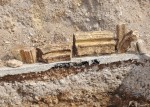

Given these giant glaring exes marking the spot, and the huge turnout of 1,500 people who lined up to see the dig during the three hours it was open this past Saturday, the Leicester City Council agreed to extend the dig for at least one more week. It was supposed to have stopped Monday, but they couldn’t quit when they were so close, and the dig has been a huge boon for Leicester making the press all over the world.
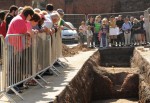 Then, early this morning, the University of Leicester announced that human remains have been found. That’s all they said. No further details until the press conference today at 11:00 AM BST which is being tweeted live on @uniofleicester. If you don’t want to follow on Twitter, the UoL website will be posting live updates on this page. The press conference will be carried on BBC and Sky television and will be streamed live on the BBC website. I’ve tweeted Leicester to ask for a link to the live stream because I can’t find it.
Then, early this morning, the University of Leicester announced that human remains have been found. That’s all they said. No further details until the press conference today at 11:00 AM BST which is being tweeted live on @uniofleicester. If you don’t want to follow on Twitter, the UoL website will be posting live updates on this page. The press conference will be carried on BBC and Sky television and will be streamed live on the BBC website. I’ve tweeted Leicester to ask for a link to the live stream because I can’t find it.
Wake up, everyone! This is too exciting to sleep through. :boogie:
Okay I’m doing my own version of live updates just because I’m nerding out like a crazy person. UL is tweeting that they’ll be referring to people at the press conference using their initials so they just posted a bunch of names with their initials. One of the people listed is Dr. Turi King (TK), from UL’s Department of Genetics. Does that mean they’ve got something to DNA test?
BBC News live stream here! And it works in the US too! Head asploding!
* Richard Taylor: the search has resembled something out of a Dan Brown novel in terms of the twists and turns it has taken.
* Peter Soulsby, Mayor of Leicester went over a couple of historical highlights of the city. Thanks the public employees for giving up their parking and says given today’s announcement, they are going to have to go without their parking lot a little longer.
 * Richard Buckley, co director of University of Leicester Archaeological Services, is describing the site, the layout of the trenches and what was found where.
* Richard Buckley, co director of University of Leicester Archaeological Services, is describing the site, the layout of the trenches and what was found where.
* Richard Taylor, Director of Corporate Affairs: They have found the remains of two people: one fully articulated skeleton of an adult male found in the choir of the church and one disarticulated human skeleton, one female found in the presbytery.
* THE MALE SKELETON HAS UPON ON INITIAL EXAMINATION SUFFERED PERIMORTEM TRAUMA. BACK OF THE SKULL CLEAVED. ARROWHEAD FOUND IN THE BACK. SKELETON IN THE CHOIR HAS SPINAL ABNORMALITIES, PROBABLY FROM SCOLIOSIS, WHICH WOULD HAVE MADE HIS RIGHT SHOULDER APPEAR CONSIDERABLY HIGHER THAN HIS LEFT SHOULDER.
* Now Richard is telling me to calm the hell down because this isn’t any kind of sure thing, but it is exciting circumstantial evidence. Next up extensive testing and analysis.
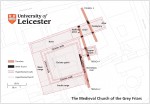 * The location and modesty of the burial is in keeping with the historical sources, but the skeleton was not hunchbacked as Richard was described by Shakespeare and other sources. He was strong and appears to have died in battle. Historical sources invested physical deformity with spiritual deformity and could well have exaggerated Richard’s disability.
* The location and modesty of the burial is in keeping with the historical sources, but the skeleton was not hunchbacked as Richard was described by Shakespeare and other sources. He was strong and appears to have died in battle. Historical sources invested physical deformity with spiritual deformity and could well have exaggerated Richard’s disability.
* Philippa Langley, lead for the Richard III society, had a dream, y’all. She says we should strive to make our dreams come true. She’s very composed, but I think she’s losing it on the inside.
* Exhumation of the male skeleton began Tuesday, September 4th.
* The archaeological site is not really display quality, so it sounds like the parking lot is going right back on top when they’re through.
* Next up is laboratory analysis at the University of Leicester. They’re hoping to recover mitochondrial DNA that can be compared to the DNA of Michael Ibsen, 17th generation nephew of Richard III. DNA analysis will take up to 12 weeks.
* Only DNA can confirm that these are the remains of Richard III. Osteology can confirm that the skeletal remains matches very well what we know of Richard from historical sources.
* The arrowhead found in the skeleton’s spine was barbed. They can’t say anything more than that right now since the find is so new. The barbed arrowhead was found between two vertebrae, not embedded in the bone.
* They haven’t cleaned the skull yet, but there are a couple of injuries to it visible. They don’t know if the head injuries or the arrow were the fatal blow. The only historical source to give details on how he died was the Ballad of Bosworth Field, widely considered unreliable. In the Ballad, Richard died of a poleaxe to the head.
* Philippa Langley thinks the Tudors constructed a mythological Richard, that to get closer to the truth of what kind of person he was, see the pre-Tudor sources from before he became king.
* She hopes the archaeology of Greyfriars will bring Richard’s story to an accurate and truthful conclusion.
And that’s all folks. Amazing. A. May. Zing.
Oh my goodness!
Right? I never expected the find to be so exceptional.
I have no words…
I’m still in shock.
I wonder who the female may be. Do they have any thoughts or ideas on that?
They didn’t say and nobody asked. The poor lady was quite overshadowed, I’m afraid. I’ll keep my eye out for further info about her, though.
I am just curious because it seems odd that a female would be buried in a monestary. Especially buried in an area that is only for clergy. Thanks
Well, her skeleton was disarticulated, so it’s possible she wasn’t originally buried there. Her remains could have been victimized during the dissolution. I’ve emailed the University of Leicester press office asking if they have any more information about her.
Hehe, I had already assumed that, since being moved after being buried elsewhere was not unheard of at that time. However, even reburied, it seems strange that they would stick her in a clergy-only area. Thanks again.
If it was dissoluters, they wouldn’t have had much concern for Franciscan strictures. But I’m jumping the gun by speculating this much. The archaeologists probably don’t even know much more than that she exists at this point.
I know all of this is speculation. Unfortunately I am just curious as all get-out.
You and me both. :hattip:
I freakin’ love this blog. Thank you!
Thank you!
Anxiously awaiting the discovery Of this famouse King. Thanks for this post keeping us all alert.
It will be a few months before the DNA can confirm whether it’s him, but you can trust that I’ll be paying close attention every step of the way.
this is blowing my mind right now. the fact that Richard could have been found and underneath a parking lot of all places. bizarre but still fascinating. thanks for the updates.
My pleasure. Thank you for sharing in my nerdcitement. I’m still on an adrenaline high.
I’m a daily lurker, but seldom poster.
This, however, is so cool. It might not rank quite up there with finding Peter’s bones under the alter, but it’s extremely cool.
Waidmann
I think in some ways it beats it, because Peter’s bones have been said to be there all this time, under the close guard of people who love him. Poor Richard’s bones, on the other hand, were said to have been thrown into a river a generation later by the same faction that killed him and hanged his dead naked body for everyone to jeer at.
I considered the possibility that they might actually find Richard’s remains, but it was really entirely academic. I never thought it would happen, and in two weeks, no less!
Altar.
I hate it when that happens.
Waidmann
Ah, typos. As irritating as they are, I have come to accept them as old friends I can never be entirely rid of. 😉
I read this blog everyday. history nerds unite!
Huzzah!
AMEN!
Mine is too. I like to study teh Tudors, and really anything to do with the monarchy in England. Just think, those artifacts will probably be in a museum one day.
Oh for sure. The town of Leicester is on an even greater adrenaline high than we are. They’ll recover every tiny piece of everything they find to put it on display before they get their parking lots back and the site is covered up.
but why not move the parking lot and continue the dig? it would definiately put them on the map and besides that church was a big deal for any Henry VIII fanatic. if you cover up the site, would it not erase all that they were accomplishing?
I think their reasoning is that the architectural remains on the site itself are not terribly impressive — low walls, a few tiles — so the good stuff can be removed. I imagine like many old cities with tight spaces parking is at a premium, so the lot value may trump the archaeological/tourist value.
Myself, I’d never cover it back up, but low walls and a few tiles are a billion times better than parking from my perspective. City councils have different priorities.
Why would city council members want to park farther than two steps from thier office building door? According to the above, two parking lots are now involved.
Yes, it’s two lots now, and even the temporary loss of them has apparently been hardship enough that the council employees got thanked profusely for their patience at the press conference. The mayor was reluctant to fully commit to the site being covered back up and parking returned, though. One of the reporters asked directly and got a very mushy answer.
Seriously cool! Thank you so much.
Glad to share the great news with my fellow enthusiasts. 🙂
I agree with you. As a history major, it just crushes me to see that happen. Tourism is better than two parking lots any day and a piece of history like this needs to be shown in the right light, politics or not.
Agreed! When I read this this morning, we (my family and I) said that if we lived over there we’d be outside with signs insisting that it be left history instead of going back to a parking lot. All of us are history nuts over here. My pop finds this interesting because military history is his thing, my mom and I are both interested in Britain/Scotland history, so the whole family is interested in this. We do like other things, but this is an article ALL of us can enjoy. So was the thermometer post yesterday.
How wonderful that your whole family is one subset or another of history nerd. You must have great dinner table conversations.
I loved the Fahrenheit post too. When I first started writing it, I thought I’d do a quick rundown of his invention of the mercury thermometer, but then once I got to researching the scale, his personal history, his links to other eminent scientists of the time, I ended up with far more post than I expected. Finally I had to just stop myself and submit the thing before I went on into the next day. :giggle:
😮 35 royalist comments ? Never mind, I’ve seen pictures with the archaeologists digging away and, believe it or not, apparently two enthusiasts standing by IN FULL ARMOUR (!) 😀 – apparently defending the royal parking lot. … “Alas, my kingdom for a royal thighbone !”
BTW, has “Blackadder” from BBC One been a big hit over there in the U.S. ? If not, You should see the episode about Richard III and the one with the beheading of Charles I
I have the complete set of Blackadder DVDs. The first series is distinctly inferior to the subsequent ones, imo. I like my Rowan Atkinson sarcastic and sharp, not addled and pratfalling all over himself.
I find it a rather odd notion that being excited about an archaeological find of such import somehow translates into support for monarchical rule. Anyway, over on this side of the ocean we dispensed with our king. We didn’t set up a Lord Protector king-in-everything-but-name to take his place either.
I am an American, so I cannot be a royalist, also, you cannot study the history of any country that is/was a monarchy without stumbling on something royal no matter how hard you try, nor can you just “skip” that stuff just because monarchies irritate you. I cannot even study U.S history without studying more than 150 years of monarchy.
This whole thing just has me floored. Stuff like this isn’t supposed to happen in real life, right?
Anyway, I just wanted to say thanks for your excellent coverage (and the blog as a whole). Keep up the great work.
It really does seem like something out of an Indiana Jones movie. Only with fewer snakes. Also less stealing and less destruction of archaeological context.
Thank you for your kind words and for reading. :thanks:
I do not know about the popularity of Blackadder in other households, but I have never seen any, and no one I know has mentioned seeing any either.
Oh, almost all of it is exceptional. There are a several episodes that literally make me weep with laughter even though I’ve seen them multiple times over the years. If you have Netflix, it’s available for streaming. Given all the history lovers in your family, I think you would get a big kick out of it.
Yes, LD! This is all very cool… I am speaking softly and slowly… Now unplug your computer, stay seated, breath regularly and think pleasant neutral thoughts. A swat team is on its way to get you out before you start hyperventilating. Then we go in after Philippa Langley.
I’m afraid it’s far too late to prevent hyperventilation now. I’ve been panting like a pug in the desert for a good 8 hours. Philippa, on the other hand, kept it together all day only to fall into complete hysterics the instant she got home. One minute crying, the next minute laughing, the next minute doing a happy dance not unlike the electric slide only jazzier.
Thomas Wolsey, buried in the nearby Augustinian abbey in 1530, would be an interesting second act.
Is the burial spot unknown? I thought there was a memorial monument marking the burial site.
What specifically is it about? I mean here our PBS shows british stuff like Keeping up Appearances. I heard that it is comedy stuff, but I have no clues beyond then that. (I do not have Netflix)
Rowan Atkinson, the guy who plays Mr. Bean, portrays a character from subsequent generations of one fictional family whose fortunes degenerate from era to era. In the first season he’s a fictional Plantagenet prince. In the second he’s a lord at the mercy of Queen Elizabeth I. In the third he’s a butler to Prince George, the Prince Regent, a complete idiot played brilliantly by Hugh Laurie (aka Dr. House). In the fourth he’s a captain on the Western Front during World War I. There are a few specials interspersed there, including one dedicated to the English Civil War which our Roundhead friend above referenced.
It’s witty and sarcastic and far more historically erudite than anything you’re likely to find on US television. Definitely worth a rent or a borrow. I don’t care for the first season, as I said, but it does set up the context for the Blackadders’ future failures.
I hope they at least reserve the parking space over his burial site for him.
Reserved Parking
Richard III
KING ONLY
Towing Strictly Enforced!
😆 That is the absolute least they could do.
About your history nerd family conversation post. Yes, we all are, and we do have great conversations. However, there are history subjects that we do not share, but this is one we all appreciate, but from different angles. In my opinion, the thermometer belongs in a museum and I hope it ends up there instead of “hiding” in some private collection for another length of time.
I agree fervently. How sad is it that we didn’t even know it existed until now? That kind of covetousness does an injustice to us all.
Me too!
Wolsey was buried without a monument. The sarcophagus he prepared for himself was ultimately used for Lord Nelson. The memorial at the abbey is a 20th c erection (1930’s if memory serves) and does not mark the spot of his interment, which is unknown.
Re the disarticulated female skeleton in the presbytery – the most sacred part of the church, and perhaps an odd spot for a female burial in a friary, unless, maybe, a major donor – it would be interesting to know if there was a cult at the Greyfriars, associated with the remains of a female saint. The place of burial and disarticulated state of the bones might suggest this. Could it be the last-minute burial, at the dissolution, of remains formerly housed in a reliquary?
Ah, very interesting about the Wolsey burial. I suspect the Leicester City Council would be even less willing to dig up their pretty park than they were the parking lot unless archaeologists had a solid idea of where exactly to look.
Re the female skeleton, it’s certainly within the realm of the possible. I wonder if there are any pre-dissolution sources that describe any such prominent woman — donor or saint — buried in the church.